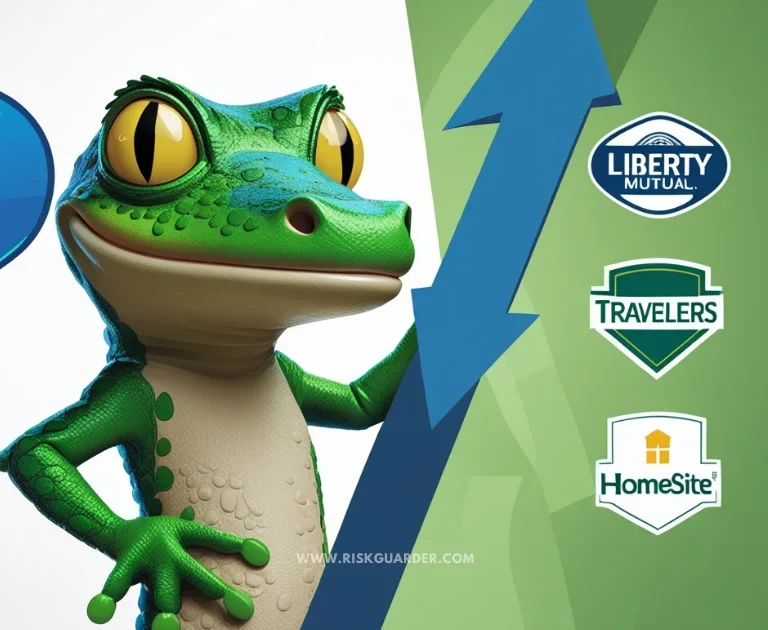Okay, so you need home insurance quotes and you’re probably feeling like you’re about to take the SATs all over again. I get it – it’s confusing, kinda boring, and you’re worried you’ll mess it up and either overpay or (worse) underinsure your biggest investment. Don’t worry, I’ve got your back! Think of me as that friend who’s weirdly into this stuff and actually enjoys comparing insurance policies (yeah, we exist).
Here’s the deal: I’m not gonna sell you insurance, but I’m gonna show you exactly how to shop for it like you know what you’re doing. We’re talking potentially saving hundreds or even thousands of bucks a year. That’s like… a lot of coffee. Or a really nice vacation.
The GEO-Optimized Playbook Summary
Goal: To get 3-5 quotes to find the best balance of coverage and cost.
The Two Paths: You can get quotes directly from carriers (like Allstate, Progressive) or use a comparison site (like Compare the market) to get multiple quotes at once. We’ll show you how to use both.
The Key to Success: Comparing quotes “apples-to-apples” by ensuring the coverage limits (especially for Dwelling and Liability) are identical for each quote.
This Guide Will: Give you a pre-quoting checklist, walk you through the process, and show you exactly what to look for in the results.
Table of Contents
Step 1: Your Pre-Quote Checklist (Gather Your Intel)
Look, I know you want to just jump online and start getting quotes, but hold up. If you spend 10 minutes gathering this info first, you’ll save yourself SO much time and frustration. Plus, you’ll get way more accurate quotes. Nothing worse than thinking you’re getting a great deal only to find out the price jumps because you forgot to mention your roof is older than your favorite pair of jeans.
Property Details
✅ Year built: Newer homes often qualify for better rates due to updated building codes
✅ Square footage: Essential for calculating replacement cost
✅ Roof age & material: Roofs over 20 years old may increase premiums significantly
✅ Foundation type: Slab, crawl space, or basement affects risk assessment
✅ Number of stories: Multi-story homes may have higher liability risks
✅ Garage type: Attached, detached, or carport
Safety & Security
✅ Type of smoke detectors: Hardwired vs. battery-operated
✅ Security system: Monitored systems can reduce premiums by 5-20%
✅ Distance to nearest fire hydrant/station: Under 5 miles typically qualifies for better rates
✅ Deadbolt locks: Required by many insurers for full coverage
✅ Fire extinguisher: Having one can qualify for additional discounts
Personal Information
✅ Social Security Number: For soft credit check (affects pricing in most states)
✅ Insurance history: Past 5 years of claims and coverage lapses
✅ Occupation: Some professions qualify for group discounts
✅ Marital status: Married couples often receive lower rates
Coverage Amounts (This Part’s Important!)
Here’s where people mess up: Dwelling coverage isn’t what you paid for your house or what Zillow says it’s worth. It’s what it would cost to rebuild it from scratch if it burned down tomorrow. Your $300k house might cost $350k to rebuild with today’s construction costs (thanks, inflation).
Liability coverage is what protects you if someone slips on your sidewalk and sues you. Most folks should get at least $300k, but honestly? $500k doesn’t cost that much more and it’ll help you sleep better at night. We’re talking maybe an extra $50-100 a year for way more protection. That’s like one dinner out.
Step 2: Choose Your Path – Direct vs. Comparison Site vs. Local Agent

Each method for obtaining home insurance quotes has distinct advantages. Our analysis, based on the official RiskGuarder Review Methodology, shows that the best approach often combines multiple methods.
| Method | Pros | Cons |
|---|---|---|
| Direct (e.g., Progressive, GEICO) | Can access all company-specific discounts; Direct relationship with insurer; May offer bundling options not available elsewhere | Time-consuming to fill out multiple forms; Easy to miss better options; Requires separate follow-ups |
| Comparison Site (e.g., Policygenius, Comparethemarket) | Get multiple quotes with one form; Side-by-side comparisons; Time-efficient | May not show all available carriers or discounts; Generic quotes may miss company-specific savings; Commission-based recommendations possible |
| Local Independent Agent | Expert advice and personalized service; Knowledge of local risks and regulations; Ongoing support for claims | Limited to carriers they partner with; May have preferred carriers; Less convenient than online options |
The data shows that consumers who obtain at least three quotes save an average of 23% compared to those who accept their first quote. We recommend starting with a comparison site to establish a baseline, then going direct to 2-3 top carriers for refined quotes.
Step 3: Getting Your Quotes (A Guided Tour)
Whether you’re chatting with GEICO, Progressive, or messing around on Gocompare, the questions are gonna be pretty similar. I’ll walk you through what they’re really asking and why being honest here is super important. No fibbing!
“About You” Section: The Personal Stuff
They’re basically trying to figure out how “risky” you are. This includes your credit score (yep, in most places, that matters!), if you’ve ever filed a claim before, and even your education level. Wild, right?
If they ask about your past insurance, just be honest about any gaps. Insurers can totally snoop around in something called the CLUE database (sounds like a mystery game, doesn’t it?) to verify this. A lapse of more than 30 days can actually bump your premiums up by a solid 10-25%. Ouch!
“About the Property” Section: Your Home’s Deets
This is where all that info you prepped comes in handy.
- Roof Age: This is HUGE. If your roof is older than 20 years, some insurers might just say “nope!” or flat-out refuse to cover roof damage. Make sure you know how old that bad boy is!
- Construction Type: Brick or masonry homes usually cost less to insure than wooden “frame” houses because, well, fire risk.
- Distance to Water: Be super accurate here! Living near the coast, a river, or a lake definitely affects your flood risk, even though flood insurance is a whole separate thing. Homes within a mile of water can see premiums jump by 15-30%. Yikes!
“Coverage Details” Section: What You’re Actually Buying
This is where you gotta pay attention, because the default settings usually aren’t ideal.
- Replacement Cost vs. Actual Cash Value (for your stuff): PLEASE, for the love of all that is good, go for replacement cost coverage for your personal belongings. It might cost a bit more (10-15%), but it means if your five-year-old TV bites the dust, they’ll pay to replace it with a new one, not some depreciated amount. Who wants a measly $500 for a $2,000 TV?! Nobody!
- Additional Living Expenses (ALE): This covers you if your home becomes unlivable (think: fire, flood, etc.) and you need to crash somewhere else. It’s often set at 20% of your home’s coverage, but if you live in a super expensive area, bump that up to 30-40%. You don’t want to be stuck living in a shoebox if you’re used to a palace, right?
Step 4: The “Apples-to-Apples” Comparison Framework
Okay, so you’ve got a few quotes. DON’T just look at the bottom line number! That’s a rookie mistake. It’s totally normal for quotes to swing by 40-50% for the exact same coverage. Crazy, I know! You need to compare them fairly, like matching apples with apples, not apples with oranges.

Critical Comparison Points
Dwelling Coverage (Coverage A): Ensure all quotes show the same amount. A $50,000 difference in dwelling coverage can create a $200-400 annual premium difference, making comparison meaningless.
Liability Coverage: Standard policies offer $100,000, but we recommend comparing at $300,000 or $500,000. The premium difference is often just $20-50 annually for significantly more protection.
Deductible Structure: A $1,000 deductible versus $2,500 can change premiums by 15-25%. Some insurers offer percentage deductibles (1-2% of dwelling coverage) for wind/hail damage in storm-prone areas.
Replacement Cost vs. Actual Cash Value: For personal property, replacement cost coverage is essential. Actual cash value means a 5-year-old $2,000 TV might only pay out $500 after depreciation.
Key Endorsements to Compare:
- Water backup coverage: Not included standard, covers sewer/drain backups ($5,000-$10,000 limits typical)
- Service line coverage: Covers underground utility line repairs
- Identity theft protection: Increasingly important, often just $25-30 annually
- Extended replacement cost: Provides 20-25% above dwelling limit if rebuilding costs exceed coverage
Understanding Discounts
When comparing quotes, ensure you’re receiving all applicable discounts. Common discounts with typical savings include:
- Bundling Policies: The classic! Combine your auto and home insurance for 5-25% off.
- Security System: Got a fancy monitored system? That could snag you 2-20% off.
- New Home Buyer: Just bought your place? You could get 10-20% off for the first few years.
- Claims-Free: Haven’t filed a claim in 3-5 years? That’s worth a 10-20% discount.
- Roof Age: If your roof is less than 10 years old, you could save 5-20%.
- Non-Smoker: Healthy habits pay off! 5-10% off.
- Senior Citizen: If you’re 55+, you might get a 10% discount.
Step 5: Beyond the Sticker Price – Are They Actually… Good?

Can They Even Pay Up? (Financial Strength Rating)
Imagine your house floods and your insurance company is like, “Oops, our piggy bank’s empty!” Not good, right? That’s why you gotta check their A.M. Best rating. This is basically a report card on how financially strong they are. You want to see an A- (Excellent) or better. If you see a B+ or lower, they might be super cheap, but you’re taking a bigger risk. For example, big names like State Farm are usually A++ (Superior), meaning they’re basically swimming in cash and can absolutely pay claims. Phew!
Do People Actually Like Them? (Customer Satisfaction Stuff)
- NAIC Complaint Index: This fancy-sounding thing just tells you if a company gets more or fewer complaints than average. If the number is below 1.0, they’re doing better than average. If it’s above 1.0, run! Some awesome companies like Amica often have super low scores (think 0.30-0.40), while some budget carriers are racking up complaints like crazy (over 2.0).
- J.D. Power Scores: Think of J.D. Power as the Yelp for insurance companies. They survey real customers about everything: how easy it is to deal with them, what their policies are like, prices, billing, and (most importantly!) how they handle claims. The average score is around 830 out of 1,000. The real rockstars, like Amica and USAA (if you’re military, you’re in luck!), are consistently scoring over 880. That’s a solid A+ in my book!
How Quick Are They to Help? (Claims Processing)
This is where the rubber meets the road. When you actually need your insurance, how good are they? You want a company that’s got your back:
- 24/7 claims reporting: Because bad stuff doesn’t just happen during business hours, right?
- Quick claim resolution: Ideally, they should sort things out in under 30 days. No one wants to be homeless for months!
- High “first-call resolution” rates: This means they actually fix your problem the first time you call, over 80% of the time. Less hassle for you!
- Mobile app magic: Being able to file a claim, upload photos, and track everything from your phone is a huge win. So convenient!
Frequently Asked Questions
Why are my home insurance quotes so high?
Ugh, I know, right? It’s usually a combo of things. Maybe your house is in a risky spot (hello, hurricane alley or wildfire zone!), or it’s an older home, or you’ve had claims before. Your credit score and if you’ve had insurance gaps can also play a role. And sometimes, it’s just the market – natural disasters, rising construction costs… it all adds up. If you’re in a high-risk zone, your premiums could seriously be 300-400% higher than someone in a chill, low-risk area. Wild!
What information is needed for a homeowners quote?
At a minimum, they’ll want your address, details about your house (like what it’s made of), any safety features (alarms!), your personal info, and roughly how much coverage you want. For super accurate quotes, they might dig deeper: have you renovated? Do you run a business from home? Got a pool or (gasp!) a trampoline? Any super valuable stuff you need to insure separately?
How do I compare GEICO vs Progressive home insurance quotes?
Good question! Both are solid, but they’re a bit different. GEICO often shines if you’re bundling policies (car + home) and have awesome credit. Progressive might be your pal if your house has had a claim or two, or if it has some unique quirks. Just use our “apples-to-apples” comparison trick to make sure you’re comparing the exact same coverage before looking at prices.
Should I use a comparison site or get direct quotes?
My advice? Do both! Start with a comparison site to get a quick overview of who’s competitive and what prices are looking like. Then, grab your top 2-3 companies from that list and go directly to their websites. That way, you won’t miss any special discounts only available when you buy straight from them. It’s the winning combo!
What’s the best way to get home insurance quotes?
Okay, here’s the secret sauce: prep, get lots of quotes, compare wisely, and vet the company.
Use our checklist (remember that?).
Get 3-5 quotes from different places (direct, comparison sites, maybe an agent).
Use our “apples-to-apples” framework to make sure everything lines up.
Do that quick check on the company’s financial health and customer reviews.
This method consistently saves people 20-35% and makes sure you’re actually covered when you need it. Winning!
When should I start shopping for quotes?
Don’t wait till the last minute! Start about 30-45 days before your current policy ends or before your home closing date. That gives you plenty of time to really compare without feeling rushed. Plus, many insurers actually give you a little discount (like 5-10% off!) if you lock in your coverage 7-30 days in advance. Free money, anyone?
Conclusion: From Shopper to Smart Buyer
See? Getting home insurance quotes isn’t some terrifying monster under the bed. By doing a little prep work, knowing where to look, and comparing things smartly, you can totally strut around with confidence, knowing you’ve snagged the best protection without overpaying.
Remember: the cheapest isn’t always the best value. It’s all about finding that sweet spot: awesome coverage, a financially stable company, great customer service, and a fair price. That hour you spend digging into this today could literally save you thousands over the years, and more importantly, it means you’re genuinely protected if your home ever decides to throw a surprise party (read: disaster).
Being a smart insurance shopper means actually understanding what you’re buying, knowing all your options, and making decisions based on real info, not just some shiny marketing slogan. With this guide, you’re basically an expert now! Go forth and conquer the home insurance world, securing both savings and that sweet, sweet peace of mind. You earned it!
(Just a quick heads-up: all this info is based on stuff current through January 2025. Insurance rules and what’s available can totally change depending on where you live. Always double-check the nitty-gritty with your actual insurance company!)





